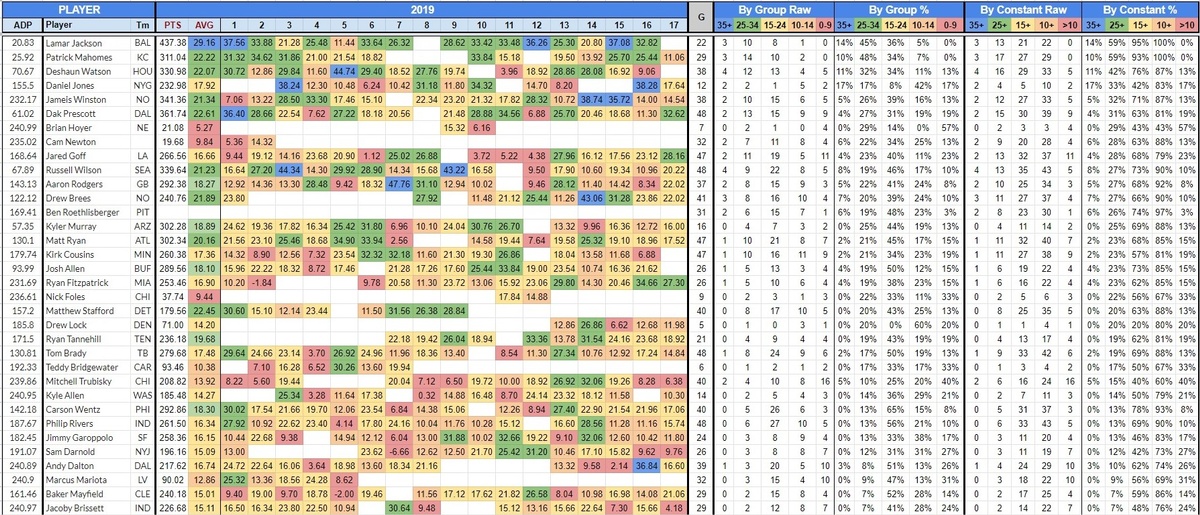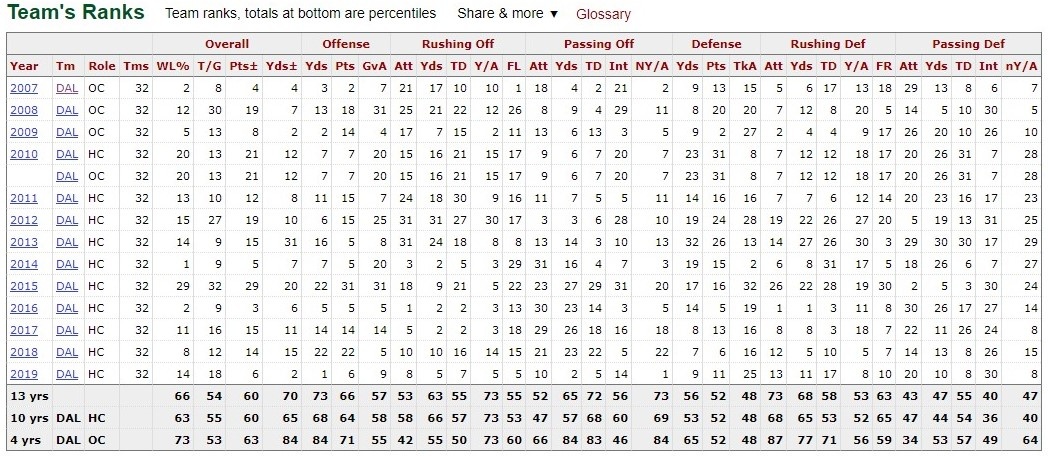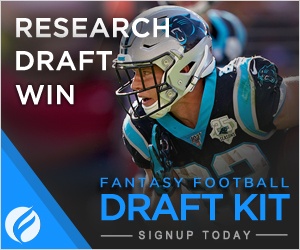For the month of May, Daniel Jones has been drafted as the QB13 in BestBall10’s ADP, QB15 in Fantasy Pros, and QB17 on Fantasy Football Calculator. I prefer to use BB10 as my compass for ADP, as these consist of drafts that require skin in the game and have sharper players. However, you can see from this range that he is not being considered a starting QB in 12 team leagues. In redraft, many owners will only take 1 QB and then worry about the position for a bye week or injury fill-in. If we’re looking at Fantasy Pros and FF Calculator from that lens, then he is either going undrafted or is one of the last QBs taken. While basic economics indicate we don’t need to over-spend to take him, data shows we might want to consider him as either our late-round starter or upside back-up. As the summer wears on, I believe he will eventually start coming off the board higher than he is now.
Why do I think this?
One of the first projects I work on each year is a ceiling/floor finder where I try to establish a group of players that can be league winners based on their prior three-year performance. This project can also identify players with safe floors combined with that home-run upside. Right away I was struck by Daniel Jones data. Of all the QBs being drafted in BestBall10 drafts, Jones finished 4th on my list for the highest percentage of games above 25 points and number one in percentage of games above 35 points (not including his week one action, see chart below). That is league-winning potential if he continues on this trajectory. His floor numbers weren’t as pretty, but we were also dealing with a rookie QB with a bad play-caller and a skill group that had trouble staying on the field, including himself.
NOTE: Only 2019 is visible to allow for the refined data to be easily displayed. ADP is from BB10 drafts held between May1-May31.
You may also notice from the chart that Dak Prescott has put up a 25+ point game 31% of his games over his last 3 years. Looking at just last year that number jumps to 37.5% of his games. What’s the common denominator here? Jason Garrett. Garrett gets a bad rap as a head coach but he has coordinated a top 10 passing offense in 7 out of his 13 years as an OC/HC. When we look at Garrett as just the OC, then he’s 4 for 4 in the top 10, which includes 13 games with Brad Johnson and Jon Kitna slinging the rock. While Garrett is no QB whisperer this tells me Danny Dimes is in, at least, solid hands with the former QB (Garrett) developing him and calling the plays, without the distraction of being the head coach.
What did Jones do last year?
Jones was bottom third in PFF’s passing grades (22nd among QBs that started at least 10 games) and only had a 61.8% completion rate in his 12 starts (only 8 starting QBs were worse). Obviously, this isn’t something we would like to see continue if he is to live up to this upside expectation. Looking at Garrett’s QBs over the years, his starters have an average completion rate of 65.9%. This drops a bit to 64.6% when looking at Garrett as just the OC – with Tony Romo at QB. Either number represents an improvement for Jones, and Garrett has only one year with a QB with a worse completion percentage than Jones did his rookie year. We should be able to expect a rookie QB to progress in several statistical categories as they develop, starting with more passes being completed. This should increase his low Yards Per Completion stat of 10.7, thus allowing his fantasy points to increase exponentially per pass completion. Giants head coach Pat Shurmur had to rely heavily on his rookie QB last year while the centerpiece of the offense (Barkley) missed 3 games and played hurt in several more. This pushed Jones to an elevated pass per game rate of 37.9 per game as a starter. By comparison, Dak Prescott, who had his weapons healthy last year was just behind Jones at 37.3 passes per game, so we could see the same level of pass plays per game, only now we might expect more to be completed and score more fantasy points.
A look at NFL Next Gen Stats shows Jones was a top 10 QB under-pressure. An impressive feat for a rookie playing behind a bad OL. The Giants went out of their way this off-season to turn off the flood gates and give Jones time to throw, and Barkley room to run – a mutually beneficial proposition for both men. They selected Andrew Thomas with the #4 overall pick, then drafted two more offensive linemen in the 3rd and 5th rounds, while also bringing in Cam Fleming who played the last two years in Dallas under new OC Jason Garrett. In 2019, Jones ranked as the third most aggressive passer per Next Gen’s Passing stats. Although his expected completion percentage was low, that area of his game could improve, as it did for Lamar Jackson last year, who also had high aggression with low expected completion percentage. Alas, let us not forget that running QBs can rack points a bit heavier than traditional pocket passers due to the rushing points (0.1 per yard) versus passing points (0.04 per yard) awarded in PPR formats. As a rusher, Jones finished 8th in Rush Attempts Per Game and 6th in Rush Yards Per Game among QBs with at least 10 games played (not including week 1).
Is Garrett a reason for optimism?
Along with a revamped offensive line and a group of skill position players that are starting the year with a clean bill of health (Engram may be a concern) and no suspensions (Tate suspended 4 games last year), Jones will be running a new offensive system. Jason Garrett runs a version of the Coryell offense which is known for vertical route patterns and a power running game. In addition to getting play-makers like Slayton and Engram down-field on verts, we should see Tate and Shepard take on the shorter to intermediate routes and allow Jones to build up his completion percentage. Garrett will use a lot of slants in his scheme, too, which Tate and Shepard will be adept in running. Slayton and Engram give the Giants home-run threats which will help Jones put up big fantasy outings when those games hit. Barkley will keep defenses honest with his rushing prowess and allow Jones to operate a bit more freely. However, Barkley himself may fall short on targets as that is less of a component of Garrett’s offense. For reference, Zeke topped out at 77 targets as the lead back in Dallas.
Garrett receives criticism for being run-heavy and slow-paced. So what? Here are Garrett’s starting QB’s fantasy points per game ranks since 2007: 3rd, 8th, 7th, 9th, 8th, 8th, 10th, 7th, 39th (Romo injury), 6th (Dak’s rookie year), 14th, 13th, and 3rd. The first four numbers were from Garrett’s coordinator years, while things dipped with Linehan as the OC, even though Dak had a fantastic rookie year under Linehan/Garrett. If Jones can improve his deep passing game he could be an arb play to Dak Prescott for the Giants this year at a major discount in ADP. Even if Jones doesn’t become Dak but manages to fall within the average range of Garrett’s QB points per game finishes, he’s still a great value. If we want to look at Dak’s rookie year to second-year leap as a deep passer under Garrett (and Linehan) we can see he went from a 41.9% Adjusted Deep Ball Completion percentage, per PFF data, to 46.5%. This was enough to boost him from 27th to 11th in that category in just one year.
What are some downside risks for this expectation?
Jones lost 11 fumbles in 13 appearances last year which doesn’t help his team stay on the field and allow him to gain more opportunities to make plays. Jones may not have a reliable center to start the year which could exacerbate this issue. Jones ranked 27th in Fantasy Data’s True Passer Rating metric and only 22nd in PFF’s pass grades among QB that started at least 10 games. If that continues, then it could diminish his chances to reduce his frequency of low floor games that have gone along with the monster games he’s already registered. We would also need to see improvement on his deep ball passing since he’s going from a West Coast Offense to a Coryell Offense which will ask for more deep throws. He does have a rapport with Darius Slayton on the deep ball. Slayton ranked 1st on NYG in Air Yards per target in our metrics, while seeing a team-high 25% of his targets coming on the deep ball. This new offense may also take a few games into the year before it finally gels, since teams will have setbacks due to the covid shut-downs.
Final Thoughts
At cost, I’m bullish on Jones’ fantasy outlook this year. While there may be some downside risk, it comes at a discount for what we’d pay to get one of the other mobile gunslingers that have a talented supporting cast. If Jones and the Giants look good or start getting positive press during camp and preseason, then we’ll likely see his cost rise. For now, grab him late while you can and steal those 33% of game with 25+ points that are being overlooked by your league-mates.



